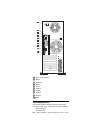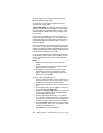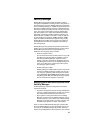70 Netfinity 3500-M20 – Type 8657 Models 21Y, 22Y, 31Y, 32Y,
Failover for redundant Ethernet
The IBM Netfinity 10/100 Ethernet Adapter or the IBM
10/100 Ethernet PCI family of adapters are optional redun-
dant network interface cards (NIC adapter) that you can
install in the server. If you install this NIC adapter and con-
nect it to the same logical segment as the primary Ethernet
controller, you can configure the server to support a
failover
function. You can configure either the integrated Ethernet
controller or the NIC adapter as the primary Ethernet con-
troller. In failover mode, if the primary Ethernet controller
detects a link failure, all Ethernet traffic associated with it is
switched to the redundant (secondary) controller. This
switching occurs without any user intervention. When the
primary link is restored to an operational state, the Ethernet
traffic switches back to the primary Ethernet controller.
High Performance Ethernet Modes
The Ethernet controller supports optional modes, such as
teaming, priority packets, and virtual LANs, which provide
higher performance and throughput for the server.
Teaming Mode:
The Ethernet controller provides
options, called
teaming options
. These options increase
throughput and fault tolerance when running with Windows
NT 4.0 or NetWare 4.1x or later.
• Adapter fault tolerance (AFT) provides automatic
redundancy for the adapter. If the primary adapter fails,
the secondary adapter takes over. Adapter fault toler-
ance supports from 2 to 4 adapters per team.
• Adaptive load balancing (ALB) allows you to balance
the transmission data flow among 2 to 4 adapters. ALB
also includes the AFT option. You can use ALB with
any 100BASE-TX switch.
• Cisco Fast EtherChannel (FEC) creates a team of 2
to 4 adapters to increase transmission and reception
throughput. FEC also includes the AFT option. You
can only use FEC with a switch that has FEC capability.
Teaming requires you to install at least one additional Ether-
net adapter. For additional information about the teaming
modes, refer to the documentation that comes with these
additional adapters.
Priority Packet Mode:
Priority Packet is a traffic-prioriti-
zation utility that enables you to set up filters to process
high-priority traffic before normal traffic. You can send infor-
mation from critical nodes or applications with an indicated
priority. Because you set this priority at the host or entry
point of the network, the network devices can base forward-
ing decisions on priority information defined in the packet.
Priority Packet information is available on the IBM Network-
ing Web site at: http://www.ibm.com/networking/support.
Priority Packet prioritizes traffic based on priority filters.
These are parameters you assign to outgoing (transmit)
packets. Using the Priority Filter Wizard, you can set up pre-
defined or custom priority filters based on a node (MAC)
address, Ethernet type, or by various properties of the proto-
col and port. Priority Packet provides two different methods


















